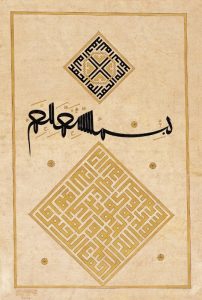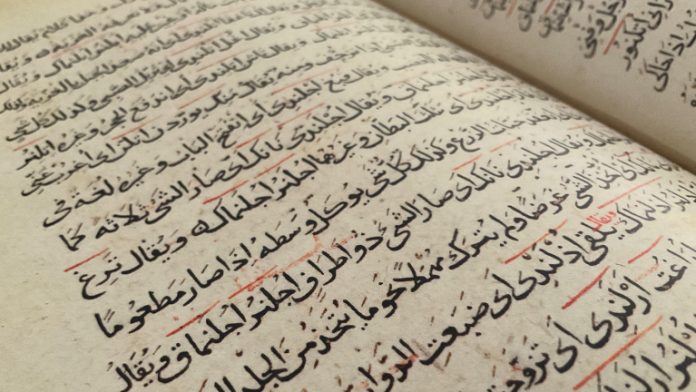How does a human being differentiate from an animal? This question can be answered in a number of ways. However, here the answer that I wanted to give is their capability to process knowledge. Since the beginning of their time on Earth, humans have been and are still producing knowledge whenever they encounter a problem to be solved or want to make things better. Nevertheless, the production of knowledge through various methods brings the problem of “storage”. How do we store what we produce? The answer to this question also differentiates and evolves throughout the history. The first examples of methods of storing knowledge are cave paintings.

As
in the Image I, those cave images
can contain information about
their surroundings, a nearby herd
or impending danger (Lascaux cave: Hall of Bulls 2019). However, as it seems, these cave paintings
can contain very scarce amount of information in comparison to other forms of storage. Later on,
hieroglyphic type of writings started to occur. Basically, there are images which have their own
meaning and by combining them afterwards, we form a sentence. The most famous hieroglyphic
writings are in Egypt and their mystery had been solved thanks to a block of stone called “Rosetta
Stone” (2022). Furthermore, alphabets started to occur and the method that we use to write today
also started to shape itself. After many historical breakthroughs, humanity has finally reached to an
era in which they use alphabets to form words and sentences. Overcoming the writing problem by
inventing alphabets was indeed a huge breakthrough, however, now there is this question of
“storing” those written materials. There had been a lot of trials with a plenty of writing material
variations. Good and quality materials could last so many years but their prices make writers and
scribes unable to produce more, such as parchment which comes from Anatolia, Pergamon, or
animal bones. Cheap and less quality materials, such as huge plant leaves or wood, could be an
affordable choice but their longevity is not something we admire today. After its long journey from
China, paper finally reached to Baghdad around 800 (Paper, 2020) and through that way, the paper
finally reached to Europe.
Before the invention of practical and convenient printing press, all of the books were copied by scribes by hand.

Uninterestingly, this was dreadfully slow process. It is widely estimated that a Image I: Lascaux cave: Hall of Bulls scribe could only write 20 books in his lifespan, which is inexplicably low in comparison to printing press. However, there we need to pay tribute those scribes because of the work that they undertook. In the absence of them, we would have never known about the scholars, roots of sciences that we deal with today.
Printing press was not an unknown idea in the Middle Ages. This invention has its roots to China, way before than the invention of Johannes Gutenberg. However, their ineffectiveness and enormous require for labour made them out of favour. Since they wear out easily, they could not press big volumes of books or materials. Johannes Gutenberg, a talented blacksmith and entrepreneur, did a tremendous job by imagining a movable type and executing this dream. If we were to answer why the printing press did not enhanced in China but in Europe, we need to scrutinise Europe’s history back then. Although it is another essay’s topic, the foundation and background of flourish of the printing press in Europe lies in religion. In the 15th century, religious unity started to scatter because Martin Luther has sown dragon’s teeth amongst people and make them question the authority of the Church. This religiously unstable environment has given birth to severe debates amongst scholars and to spread their ideas and opinions out, scholars and the Church started to use the printing press, and the rest is history.
Whereas the so-called late arrival of the printing press to Islamdom needs to be spoken of it. It is widely accepted that presence of printing press in Ottoman lands comes from Jews who were rescued from Spain (Beydilli, 2003). The reasons why Jews adopted printing press so quickly are plenty but there are two fundamental reasons for supporting printing press: the first is that since hand-written books can easily disappear or soak up moisture and become completely useless or be burned, it is inexplicably good to have a lot of copies of them. The second is a little bit more Image II: Ahmet Karahisari’s Calligraphy (2022) religious. Starting from 12th century, Jews had always been persecuted by Christians and their holy books occasionally were being collected and burned. Because of this application, there arose the problem of preserving their religious materials. Because all of these, they tended to look printing press very positively and even say “ Those whoever speak against printing press shall suffer from this sin.” (Meral, 2020)
Although its reason remains vague, in the reign of Beyazid II, in 1485, a ban was issued by
the sultanate to carry and obtain printed material, which afterwards reapproved by Selim I, and this
ban, with admirable efforts of Yirmisekiz Mehmet Çelebi and his son, Said Efendi, was lifted for
only non-religious books (Pedersen, 2018). The first printing press was established under the
supervision of İbrahim Müteferrika, also known as Basmacı İbrahim Efendi (Afyoncu, 2000). The
first works printed by İbrahim Müteferrika tell us about the underlining aim of that press. When we
look at the first ever printed materials, we can see maps and books related to geography, alongside
with the groundbreaking book of Katip Çelebi, Cihannüma. So, as Mermutlu indicates in his article
(2008), employing the printing press in Ottoman lands is not a Westernisation process, on contrary,
it was a probable answer to the West. The reason for telling this is that maps and geography books
are military-oriented materials and if we take the military conditions of this era into consideration,
they thought that they can use the printing press and its opportunities to overcome the difficulties
that the West caused. The printing press that İbrahim Müteferrika established had continued its
journey for a long time. Although Pedersen (2018) claims that this printing press was closed in
between 1745-83, Afyoncu says that the press was closed for only one year because of the outbreak
of the Patrona Halil Uprising. Later on, in 1803, even though its reason remains unknown, by the
publication of “Risale-i Birgivi”, a book related to the Islamic Creed, the ban on printing religious
books was lifted de facto. (Candan, 2011)
Furthermore, we need to talk about the delay in the arrival of the printing press to the
Ottoman Empire. There are plenty of scholars who claim that this “neglect” or “carelessness” about the printing press is the reason why the Ottomans retreated in a lot of fields. However, to not read the history from today’s reality, we need to ask the question of “Did Ottoman Scholars need this kind of spread of books?” As Edward William Lane, a famous translator of Arabic and lexicographer, narrates that Muslims of those times were afraid of possibility for the name Allah to lose its purity if they print it so quickly and also they were afraid of that if they print and make books cheap, evil-minded individuals could try to detriment books and related studies (Pedersen, 2018). However, as I showed before, did they need to print these books? According to Nil Pektaş, Ottoman court was not interested in printing an official edition of Quran or hadith collections or celebrated tafseer books (2015) Also there was another aspect that needs to be taken into consideration, workers involved with book writing. A visitor of İstanbul, Luigi Fernando Marsigli, estimates that there were 80,000 workers were involving in the manuscript production, just in İstanbul alone (Pektaş, 2015). As I said before, there was a religiously unstable environment in Europe and they employed printing press as a medium to spread their ideas. However, if we look at corresponding times of the Ottoman Empire, it is impossible to see that kind of religious debates.
As expressed above, the history of printing press is very complicated and related to other
parts of world history. Due to its invention and wide use, a lot of people lost their jobs and a lot of work fields such as scribe had disappeared. What about its future? We are in an era in which printing technology is threatening not just one field but numerous. From producing small toys in our homes to constructing actual houses, 3D printing technology is shaping our now and future. Alongside with the 3D printing technology, we are experiencing a revolution of smart devices by which people get the knowledge they want. Although the printing press sits on a firm and stable throne, this idea of “online reading” or “screen-reading” will surely affect, or even harm the longlasting reign of the printing press.
References
- Afyoncu, E. (2000). İbrahim Müteferrika. In TDV İslam Ansiklopedisi (pp. 324-327). İstanbul, Turkey: Türkiye Diyanet Vakfı. Retrieved September 14, 2022, from https://islamansiklopedisi.org.tr/ibrahim-muteferrika
- Ahmet Karahisari Hattı. (n.d.). Turan Akıncı. Retrieved September 14, 2022, from https:// www.turanakinci.com/portfolio-view/hattat-ahmet-semsettin-karahisari/.
- Beydilli, K. (2003). Matbaa. In TDV İslam Ansiklopedisi (pp. 105-110). İstanbul, Turkey: Türkiye Diyanet Vakfı. Retrieved September 14, 2022, from https://islamansiklopedisi.org.tr/matbaa#1
- Britannica, T. Editors of Encyclopaedia (2022, April 25). Rosetta Stone. Encyclopedia Britannica. https://www.britannica.com/topic/Rosetta-Stone
- Britannica, T. Editors of Encyclopaedia (2020, February 14). Paper. Encyclopedia Britannica. https://www.britannica.com/technology/paper
- Candan, B. (2011). Matbaadan İnternete Türkiye’de Yayın Hayatı ve Kütüphaneler . Türk Kütüphaneciliği , 25 (4) , 470-493 . Retrieved from https://dergipark.org.tr/tr/pub/tk/issue/48853/622422
- Meral, Y. (2020). Yahudi Âlimlerin Gözüyle Matbaanın İcadı ve Matbaada Basılan Metinlerin Hükmü . BELLETEN , 84 (300) , 559-584 . DOI: 10.37879/belleten.2020.559
- Mermutlu, B. (2008). THE POLITIC MEANING OF OTTOMAN PRINTING HOUSE . Uludağ Üniversitesi Fen-Edebiyat Fakültesi Sosyal Bilimler Dergisi , 9 (15) , 297-318 . Retrieved from https://dergipark.org.tr/tr/pub/sosbilder/issue/23135/247142
- Pedersen, J. (2018). İslam Dünyasında Kitabın Tarihi (M. M. Karagözoğlu, Trans.; 3rd ed.). Klasik Yayınları.
- Pektaş, N. (2015). The Beginnings Of Printing In The Ottoman Capital: Book Production And Circulation In Early Modern Istanbul. Osmanlı Bilimi Araştırmaları, 16(2), 3-32.
- Lascaux cave: Hall of Bulls. (2019). Encyclopædia Britannica. Retrieved September 13, 2022, from https://www.britannica.com/place/Lascaux#/media/1/330866/250886.





